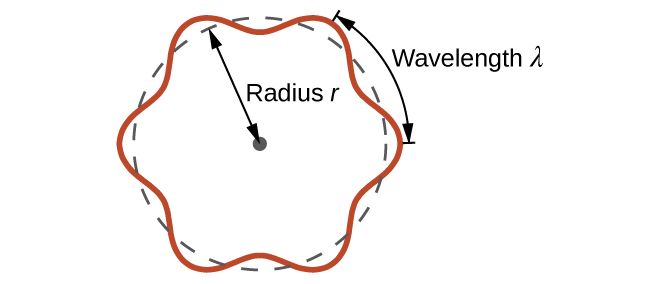We understand that macroscopic objects visible to the naked eye follow the rules of classical physics. For example, a billiard ball, moves in a straight line unless acted upon by forces like collisions or friction. It has well-defined position and velocity (or well-defined momentum, p = mv, mass m and velocity v) at any given moment. In other words, the ball is moving in a classical trajectory, behaving like a particle. This is the typical behavior of a classical object.
In contrast, waves interacting with each other, create interference patterns, unlike macroscopic particles such as billiard balls. For instance, water waves can produce interference patterns, demonstrating distinct wave behavior (Figure 1). This clearly shows that particles and waves behave differently on a macroscopic scale.

As technological improvements allowed scientists to probe the microscopic world in greater detail. By the 1920s, it became clear that tiny pieces of matter followed rules differently from those observed for large objects. The unquestionable separation of waves and particles was no longer the case for the microscopic world.
Louis de Broglie and The Microscopic World
Louis de Broglie was one of the first people to explore the special behavior of the microscopic world. He asked the question: If electromagnetic radiation can have particle-like character, can electrons and other submicroscopic particles exhibit wavelike character? In his 1925 doctoral dissertation, de Broglie extended Einstein’s wave-particle duality of light to material particles. He predicted that particles with mass m and velocity v – or linear momentum p – should act like waves. The wavelength value λ, given by:
$$λ=\frac{h}{mv}=\frac{h}{p}$$
Here, h represents Planck’s constan and this wavelength is known as the de Broglie wavelength. Unlike the other values of λ discussed, the de Broglie wavelength characterizes particles and other bodies, not electromagnetic radiation. Note that this equation involves velocity [v, m/s], not frequency [ν, Hz]. Although these two symbols appear nearly identical, they mean very different things). Bohr proposed that electrons orbit the nucleus in quantized orbits as particles. De Broglie argued that the quantization of orbits becomes clear if we view electrons as circular standing waves. In De Broglie’s view, only an integer number of wavelengths can fit exactly within the orbit (Figure 2).

For a circular orbit of radius r, the circumference is 2πr, and so de Broglie’s condition is:
$$2πr=nλ,\quad n=1,\;2, \; 3, \; . \; . \; .$$
C. J. Davisson and L. H. Germer’s Interference Pattern with Electrons
Shortly after de Broglie proposed the wave nature of matter, two scientists, C. J. Davisson and L. H. Germer, conducted experiments at Bell Laboratories. They demonstrated that electrons exhibit wavelike behavior by showing an interference pattern when electrons travel atomic pattern in a crystal. The regularly spaced atomic layers served as slits, as used in other interference experiments. Since the spacing between the layers serving as slits needs to be similar in size to the wavelength of the tested wave for an interference pattern to form, Davisson and Germer used a crystalline nickel target for their “slits,” since the spacing of the atoms within the lattice was approximately the same as the de Broglie wavelengths of the electrons that they used.
Figure 3 shows an interference pattern, similar to light patterns observed with narrow slits. Figure 3 shows the wave-particle duality through observations of electron collisions recorded over a long period of time. Initially, when researchers record only a few electrons, the electrons exhibit clear particle- like behavior, arriving in small, localized packets that seem random. As researchers recorded more and more electrons, they observed a clear interference pattern, a hallmark of wavelike behaviour.
This pattern revealed that, although electrons appear as small, localized particles, their motion does not follow classical mechanics’ equations. Instead, their motion is governed by a wave equation. Thus the wave–particle duality first observed with photons is actually a fundamental behavior intrinsic to all quantum particles.

Calculating the Wavelength of a Particle
If an electron travels at a velocity of 1.000 × 107 m s–1 and has a mass of 9.109 × 10–28 g, what is its wavelength?
Solution
We can use de Broglie’s equation to solve this problem, but we first must do a unit conversion of Planck’s constant. You learned earlier that 1 J = 1 kg m2/s2. Thus, we can write h = 6.626 × 10–34 J s as 6.626 × 10–34 kg m2/s.
$$λ=\frac{h}{mv}$$
$$λ=\frac{6.626×10^{−34}\; kg\; m^2/s}{(9.109×10^{−31}\; kg)(1.000×10^7\; m/s)}$$
$$λ= 7.274×10^{−11}\; m$$
This is a small value, but it is significantly larger than the size of an electron in the classical (particle) view. This size is the same order of magnitude as the size of an atom. This means that electron wavelike behavior is going to be noticeable in an atom.
Check Your Learning
Calculate the wavelength of a softball with a mass of 100 g traveling at a velocity of 35 m s–1, assuming that it can be modeled as a single particle.
Answer:
1.9 × 10–34 m.
We never think of a thrown softball having a wavelength, since this wavelength is so small it is impossible for our senses or any known instrument to detect (strictly speaking, the wavelength of a real baseball would correspond to the wavelengths of its constituent atoms and molecules, which, while much larger than this value, would still be microscopically tiny). The de Broglie wavelength is only appreciable for matter that has a very small mass and/or a very high velocity.
Limits of Measurement and The Heisenberg Uncertainty Principle
Werner Heisenberg considered the limits of how accurately we can measure properties of an electron or other microscopic particles. He found the fundamental limit to how accurately one can measure both a particle’s position and its momentum simultaneously. The more accurately we measure the particles momentum, the less accurately we can determine its position, and vice versa. The Heisenberg uncertainty principle summarizes this: It is fundamentally impossible to determine simultaneously and exactly both the momentum and the position of a particle. For a particle of mass m moving with velocity vx in the x direction (or equivalently with momentum px), the product of the uncertainty in the position, Δx, and the uncertainty in the momentum, Δpx , must be greater than or equal to $\frac{ℏ}{2}$. Here, $ℏ=\frac{h}{2π}$, the value of Planck’s constant divided by 2π.
$$Δ_x×Δ_{p_x}=(Δx)(mΔv)≥\frac{ℏ}{2}$$
This equation allows us to calculate the limit to how precisely we can know both the simultaneous position of an object and its momentum. For example, if we improve our measurement of an electron’s position so that the uncertainty in the position (Δx) has a value of, say, 1 pm (10–12 m, about 1% of the diameter of a hydrogen atom), then our determination of its momentum must have an uncertainty with a value of at least $$ \Delta p = m \Delta v \\ = \frac{\hbar}{2 \Delta x}\\ =\frac{1.055\times 10^{-34}\; kg\; m^2 s^{-1}}{2 (1 \times 10^{-12}\; m)} \\ =5\times 10^{−23}\; kg\; m/s$$
Heisenberg’s Uncertainty Principle: Limits of Measurement and the Relationship Between Energy and Time
The value of ħ is not large, so the uncertainty in the position or momentum of a macroscopic object like a baseball is too insignificant to observe. However, the mass of a microscopic object such as an electron is small enough that the uncertainty can be large and significant.
Heisenberg’s uncertainty principle extends beyond uncertainties in position and momentum to also link other dynamical variables. For example, when an atom absorbs a photon and makes a transition from one energy state to another, the uncertainty in the energy and the uncertainty in the time required for the transition are similarly related, as ΔE Δt ≥ $\frac{ℏ}{2}$.
Heisenberg’s principle imposes ultimate limits on what is knowable in science. Wave-particle duality, which distinguishes modern quantum theory from classical mechanics, directly leads to the uncertainty principle.
Read this article that describes a recent macroscopic demonstration of the uncertainty principle applied to microscopic objects.